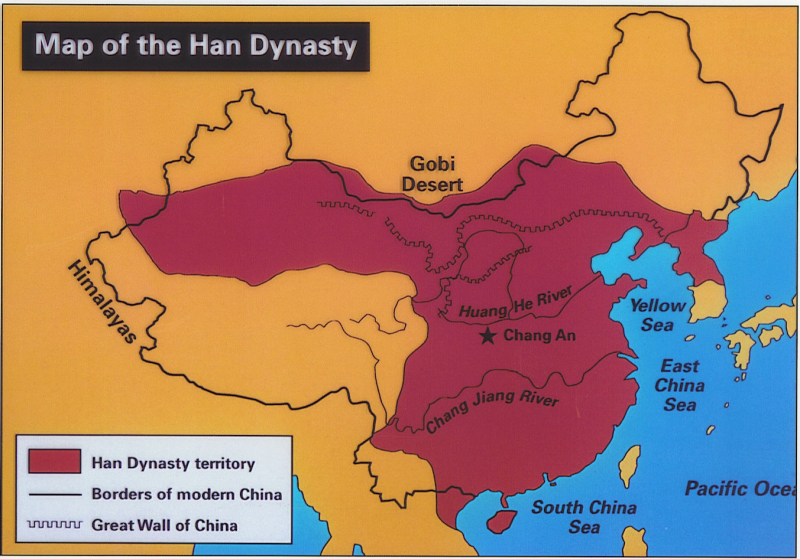The Han Dynasty

The fifth imperial dynasty of prehistoric China, the Han, governed China from 206 BC to 220 AD. As well as making Confucianism the official religion, the Han Dynasty opened up the Silk Road trading route to Europe. This changed the course of Chinese history forever. In addition, Han Dynasty creations like paper continue to have an impact on the globe today.
There are two main time periods throughout the Han Dynasty. It was the Western Han Dynasty from 202 BC to AD 9 and the Eastern Han Dynasty from 25 to 220 AD. In addition, there was a short Han era from AD 9 to AD 25 when the Xin Dynasty was in power. When China initially became united and a major power, it was during the Western Han Dynasty. During what is regarded as one of the nation's most tranquil and wealthy eras, a total of 12 emperors reigned. From 9 to 23 AD, China was controlled by the Xin Dynasty. Wang Mang was the lone ruler of this dynasty throughout its existence. Wang Mang came to power after building a reputation that was well-liked by the Chinese people. However, in AD 23, there was a peasant insurrection, and Chang'an's city was under siege. Wang Mang was put to death during the uprising, and the Han Dynasty was later reinstated by the heirs of the deceased emperors. The Xin Dynasty was overthrown, and Han rule was restored in AD 23. When he came to power, Emperor Gengshi reestablished the dynasty, but he was viewed as an inept leader who was unable to keep the empire going. He was removed from power by the year 25 and replaced by Emperor Guangwu.
In terms of society, the emperor represented the apex of Han society and governance in the hierarchical social structure. The empress dowager or one of her male relatives often serves as the emperor's regent. The kings from the same Liu family are immediately behind the emperor in the hierarchy. All other members of society, barring slaves and lower-ranking aristocracy, belonged to one of the twenty ranks. Government officials belonged to the larger common class and were only somewhat less prestigious in society than the nobility.
The monetary economy, which was originally formed during the Zhou dynasty, underwent substantial growth during the Han dynasty, which also saw a time of economic boom. Up to the Tang dynasty, coins produced by the central government in 119 BC were the norm in China (618–907 AD). Some minor institutional innovations occurred during this time. The Han government nationalized the independent iron and salt businesses in 117 BC to provide money for military campaigns and the settling of recently captured borderlands. Furthermore, significant advancements in science and technology occurred during the Han Dynasty, including the creation of paper, ship rudders for ships at sea, the use of negative numbers in arithmetic, supporting maps, and running spheres. The main direction of distant earthquakes can be determined using an inverted pendulum, hydraulic power for astronomy, and seismometers.
Regarding religious beliefs, families in China have ritually offered food and animals to gods, spirits, and ancestors in temples for centuries. They think that those in the spiritual world can make use of these things. In it, the emperor served as both the nation's foremost priest and a sacrificer to Heaven. The delicate balance of these cosmic cycles can be upset by the emperor's improper conduct, which can result in natural calamities like earthquakes, floods, droughts, and disease epidemics. In 65 AD, the Eastern Han Dynasty brought Buddhism to imperial China for the first time along the Silk Road. The White Horse Temple, constructed outside the city walls of the nation's capital Luoyang during the reign of the Ming Emperor, is said to be the earliest Buddhist temple in China. During the second century C.E., significant Buddhist texts, including the Pratyutpanna Sutra, the Perfection of Wisdom, the Shurangama Sutra, and the Forty-two Chapter Sutra, were translated into Chinese.
Pre-modern China's Han Dynasty is a time of exceptional scientific and technological advancement, with a degree of advancement equivalent to that of the Song Dynasty (960–1279). Bronze, animal bones, and bamboo or wooden boards were the usual tools for creating classical Chinese characters in the first millennium BC. By the early Han Dynasty, hemp paper, silk fabric, clay, and bamboo-strip scrolls bound with hemp rope served as the primary writing implements. They are inserted via holes that have been drilled and sealed with clay.
The Han Dynasty was disintegrating by the end of the second century AD. Emperors were more concerned with appeasing themselves than with appropriately managing state matters. Court officials jostled each other for power, and those struggles often ended in internal carnage. China was split into three spheres of influence when Cao Cao was defeated in the naval battle of Chich Bich in AD 208, with Cao Cao dominating the north, Sun Quan governing the south, and Liu Bei ruling the south. After Cao Cao's passing in December 220 AD, Cao Pi, also known as Emperor Wen of Wei, ascended the throne. This marked the formal end of the Han dynasty and the start of hostilities between the three states of Cao Wei, Dong Wu, and Shu Han.
To conclude, the Han Dynasty:
- existed from 206 BC to 220 AD.
- ushered in a period of prosperity for ancient China thanks to the Silk Road that made a trade in goods possible as far away as the Roman Empire.
- witnessed achievements in science and technology, notably the invention of paper.
- was disintegrated by the corrupt play of the emperors and power struggles by court officials.










